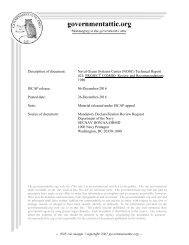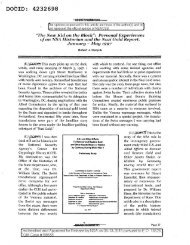insa-ic-ite
insa-ic-ite
insa-ic-ite
Create successful ePaper yourself
Turn your PDF publications into a flip-book with our unique Google optimized e-Paper software.
desktops, big data analyt<strong>ic</strong>s, appl<strong>ic</strong>ation stores, and improved security.¹ Another key driver <br />
behind this IC-‐wide strategy was that in late 2011 the Intelligence Community ant<strong>ic</strong>ipated it would <br />
need to formulate how it would take its share of the upcoming government budget reductions. <br />
The Off<strong>ic</strong>e of the Director of National Intelligence (ODNI) submitted plans to reduce the budgets <br />
of intelligence agencies over the next decade, and IC leaders expect to reap a signif<strong>ic</strong>ant portion <br />
of their savings in information technology eff<strong>ic</strong>iencies. <br />
As a result, in 2012 the IC CIO embarked on a signif<strong>ic</strong>ant IT transformation for the IC. This <br />
transformation, guided by the Intelligence Community Information Technology Enterprise (IC ITE) <br />
Strategy, focuses on enabling greater integration, information sharing, and information <br />
safeguarding through a common IC IT approach that proposes to improve mission and business <br />
processes, and substantially reduce costs. The IC ITE Strategy directly supports the ODNI strateg<strong>ic</strong> <br />
initiative of delivering global and assured serv<strong>ic</strong>es that are always functioning, accessible and <br />
taking full advantage of agile and eff<strong>ic</strong>ient mission capabilities.¹ This strategy lays the groundwork <br />
to enhance information sharing – through improved infrastructure, capabilities, business <br />
operations, governance, oversight, and strateg<strong>ic</strong> partnerships. The IC ITE Strategy intends to <br />
guide the IC IT community over the next 5 years, moving the IC from histor<strong>ic</strong>al agency-‐specif<strong>ic</strong> IT <br />
models to a new, more common arch<strong>ite</strong>cture – one that, through shared serv<strong>ic</strong>es, will become <br />
the strateg<strong>ic</strong> IT venue for the IC. A key challenge is striking the balance between fully leveraging <br />
state of the art IT and enterprise approaches, while sustaining and enhancing mission agility, <br />
information sharing, information assurance, and satisfaction of unique customer requirements. <br />
Each intelligence agency’s mission to provide secure technology serv<strong>ic</strong>es to its own stakeholders <br />
has perpetuated the independent development of infrastructure and appl<strong>ic</strong>ations, and inhib<strong>ite</strong>d <br />
data sharing across organizational and mission lines. Even in light of the ODNI plan for an IC ITE <br />
and the progress made in establishing a high-‐level vision, strateg<strong>ic</strong> direction, and engineering level <br />
standards, the Community’s IT capabilities remain largely agency-‐centr<strong>ic</strong> and independent. IT <br />
spending across the 17-‐plus agencies in the Community is estimated to be as much as 25 percent <br />
of the National Intelligence Program (NIP) funding not including IT funded as part of other <br />
program line <strong>ite</strong>ms. In the face of fiscal uncertainty, this is a log<strong>ic</strong>al area to examine for savings <br />
with the added benefit of further integrating the Community. <br />
As the IC moves towards implementing capabilities to enable discovery and data sharing to <br />
support the direction set out in IC Directive 501, leaders within the Community must accelerate <br />
the establishment and alignment of standards to allow technologists to apply leading edge <br />
capabilities in moving initiatives forward. For data to be shared across intelligence agencies, the <br />
Community will also need to rethink how it defines and executes its data security and access <br />
control in a virtualized, cloud-‐enabled delivery arch<strong>ite</strong>cture. <br />
Technolog<strong>ic</strong>al advancement and innovation in IT is being led by the private sector, often at a <br />
breathtaking pace. Prudent leveraging of these advancements has the potential to accelerate the <br />
DNI’s strateg<strong>ic</strong> intent for information sharing across agencies, intelligence disciplines and mission <br />
sets. In order to manage these histor<strong>ic</strong> changes in operations and the supporting cultural shift to <br />
enable sharing data across the IC, CIOs and technology leaders within the IC will need to <br />
restructure the coordination, synchronization, and governance model from one centered on <br />
control within stovepipes to one that fully leverages innovation across the enterprise with agility. <br />
2| Intelligence and National Security Alliance | www.<strong>insa</strong>online.org IC ITE: Doing in Common what is Commonly Done
















